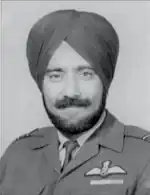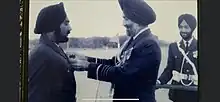Amar Jit Singh Sandhu
Wing Commander Amar Jit Singh Sandhu VrC, VM (23 January 1933 – 24 September 1971) was an officer and fighter pilot of the Indian Air Force.[1][2] He was awarded the Vir Chakra and the Vayu Sena Medal. He is credited with shooting down a North American F-86 Sabre of the Pakistan Air Force in the Indo-Pakistani War of 1965.[3][4][5]
Amar Jit Singh Sandhu | |
|---|---|
 | |
| Nickname(s) | AJS Sandhu Black leader Kala Sandhu Ajax Sandhu |
| Born | 23 January 1933 Lyallpur, British India |
| Died | 24 September 1971 (aged 38) |
| Allegiance | |
| Service/ | |
| Years of service | 1954 - 1971(Died in service) |
| Rank | |
| Service number | 4705 F(P) |
| Commands held |  No. 23 Squadron, Gnat Unit |
| Battles/wars | Indo-Pakistani War of 1965 |
| Awards | |
Early life
Amar Jit Singh Sandhu was born on 23 January 1933 in Layllpur, Punjab, British India. His family moved to Sirsa,[6]Haryana ( then Punjab),India after the Partition of India in 1947.
Military career
Amar Jit Singh Sandhu was commissioned in May 1954 as a pilot officer in the Flying Branch of the Indian Air Force as a fighter pilot. Sandhu was promoted to flying officer after one year of service in May 1955.[1]
Vayu Sena Medal

In 1964, Amar Jit Singh Sandhu was a flight lieutenant. As mentioned in his citation below,[1] he was awarded the Vayu Sena Medal for carrying out a 'deadstick' forced landing after experienced a flame out of the engine of his Gnat aircraft, followed by a total electrical failure which made it almost impossible to control the aircraft. He chose to land the plane rather than ejecting. This was the first successful deadstick landing of a Gnat.[7]
The citation for the Vayu Sena Medal reads as follows[1]
On 10th March 1964, Flt Lt Sandhu, while in formation of Gnat aircraft, experienced a flame out of engine followed by a total electrical failure rendering the tail plane inoperative. He was faced with the choice of either abandoning the aircraft and ejecting himself, or carrying out a 'deadstick' forced landing. In spite of the failure of vital services, he chose the latter in order to save a valuable aircraft from destruction. This was the first time that a 'dead-stick' landing was carried out in a Gnat aircraft. Flt Lt Sandhu also made it possible for the technical staff to ascertain the defect leading to the flame-out of the engine which, if undetected might have caused serious accidents in the future.Flt Lt Amarjit Singh Sandhu displayed courage, high professional skill, and devotion to duty whicha re in the best traditions of the Indian Air Force.
Indo-Pakistani War of 1965
Amar Jit Singh Sandhu took active part in Indo-Pakistani War of 1965 from September 1–22, 1965. He was posted to 9 squadron, but was attached to 23 squadron during the war.
He was part of the four aircraft formation sent out to ambush Pakistan Air Force aircraft on 3 September, where the first IAF aerial victory was secured, and took part in several aerial skirmishes during the war.[8][9]
Sandhu was flying the Folland Gnat at that time, which was one of the latest aircraft of the Indian Air Force. Despite this, the Gnat was not armed with missiles and only had two very powerful 30mm ADEN cannon . On the other hand, the Pakistan Air Force had F-86 Sabers and a squadron of F104 Starfighters. Both these PAF aircraft were armed with missiles.[10] The Gnat guns also had a tendency to jam.
.jpg.webp)
On 4 September, Squadron Leader J Greene, Sandhu and Flight Lieutenant Manna Murdeshwar were behind three Sabres, but all had jammed guns.[10]
On 18 September, Sandhu was able to outmanoeuvre and shoot down a Pakistani Sabre.[3][11] He was awarded the Vir Chakra for this action.
Vir Chakra
The citation for the Vir Chakra reads as follows:[2][1][12]
Squadron Leader Amarjit Singh Sandhu was the Flight Commander of an Operational Squadron, which was assigned the task of establishing our air superiority over the Pathankot region during the recent operations against Pakistan. He flew repeated missions in the Chhamb sector and over the Pasrur and Lahore areas, all the time seeking out enemy aircraft and engaging them. On the 18th September 1965, in a thrilling encounter against enemy aircraft, he was able to outmanoeuvre the enemy with admirable skill, courage and judgment and shot down a Sabre jet.
The courage and devotion to duty displayed by Squadron Leader Amarjit Singh Sandhu were in the best traditions of the Indian Air Force.
In Victor Bingham’s book, Folland Gnat: Sabre-Slayer and Red Arrow, published in 2000, he credits Sandhu with two kills on 18 September:[13] [14]
The opposite combat view was that on interception the Gnat section led by Squadron Leader A Sandhu, carried out a half roll, built up speed and climbed out. Sandhu aimed for a deflection shot on the first Sabre and saw shots strike home; then seeing another Sabre he reversed to the left and within 270 degrees in the turn came in line with the enemy aircraft, a quick burst … and the Sabre burst into flames and exploded
Command of a fighter squadron
Amar Jit Singh Sandhu was promoted to wing commander and given command of No. 23 Squadron on 30 November 1970.[1]
Death
Wing Commander Amar Jit Singh Sandhu was killed in an air crash on 24 September 1971, after he took off from Pathankot airbase, where the unit which he was commanding was based.[1] He was flying in a Gnat at night when his aircraft crashed. He was 38 at that time.
Legacy
Sandhu has an entire chapter dedicated to him in Wing Commander Dhiredra S Jafa's book, Death Wasn't Painful: Stories of Indian Fighter Pilots from the 1971 War.[15][16] He is referred to by his nicknames as “Kala Sandhu” in this book.
Several articles have also been written about him[17] and he is mentioned in several other articles about the IAF.
In official history of the Indian Air Force of the Indo-Pakistani War of 1965, he is mentioned as being the third pilot from No. 23 Squadron to have shot down a Sabre.[18]
External links
- Video – Heroes of the 1965 War — His name is mentioned in documentary published by IAF. This clip is part of complete documentary by PIB Government of India about Air war in 1965.[19]
References
- "Service Record for Wing Commander Amar Jit Singh Sandhu 4705 F(P) at Bharat Rakshak.com". Bharat Rakshak. Retrieved 2022-07-14.
- Directorate of Printing, Government of India (1965-03-13). Gazette of India, 1965, No. 27.
- B., Harry (September 2, 2006). "IAF COMBAT KILLS - 1965 INDO-PAK AIR WAR" (PDF). 1.
{{cite journal}}: Cite journal requires|journal=(help) - "Indian Air-to-Air Victories since 1948". 2012-12-23. Archived from the original on 2012-12-23. Retrieved 2023-05-29.
{{cite web}}: CS1 maint: bot: original URL status unknown (link) - "IAF kills in 1965". 2006-11-05. Archived from the original on 2006-11-05. Retrieved 2023-05-29.
- "Wg Cdr Amarjit Singh Sandhu, VrC @ TWDI". twdi.in. Retrieved 2022-09-10.
- "Indian Air Force Gallery :: Gnat IE1202 (GT-018)". Bharat Rakshak. Retrieved 2023-04-02.
- Joshi, Sameer (2019-09-06). "1965 India-Pakistan war: How IAF's heroes slayed PAF's superior Sabre fighter jets". ThePrint. Retrieved 2022-09-10.
- "Johnny Greene | Gnat50Years". 17 April 2009. Retrieved 2023-04-21.
- "IAF defeated PAF in 1965 War". Indian Defence Review. 5 July 2021. Retrieved 2022-07-16.
- "Indian Aviation - HAL Ajeet, the Folland Gnat Mk II. EDIT: 1965 war IAF documentary on page 6". Team-BHP.com. Retrieved 2022-09-10.
- "Vir Chakra (VrC), Awardee: Wg Cdr Amarjit Singh Sandhu, VrC @ TWDI". twdi.in. Retrieved 2022-09-10.
- "Folland Gnat – Red Arrow and Sabre Slayer – Bharat Rakshak". Retrieved 2023-05-29.
- Bingham, Victor (2000). Folland Gnat Sabre Slayer and Red Arrow. J&KH Publishing. p. 106. ISBN 1-900511-78-9.
- Jafa, Dhirendra S. (2014-08-27). Death Wasn't Painful: Stories of Indian Fighter Pilots from the 1971 War. SAGE Publishing India. ISBN 978-93-5150-427-6.
- "Book paints the stories of Indian fighter pilots from 1971 war". The Economic Times. Retrieved 2022-09-10.
- "The Story of Kala Sandhu - Bharat Rakshak". forums.bharat-rakshak.com. Retrieved 2022-09-09.
- "Our Operations". Indian Air Force: Touch The Sky With Glory. Retrieved 2022-09-10.
- 1965 INDO-PAK Air War, retrieved 2022-09-10